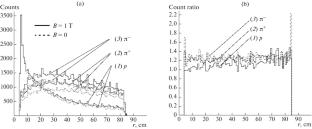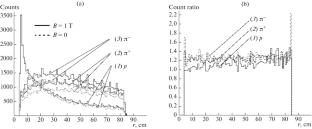NICA SPD光束计数器pp-散射模拟的新结果
IF 0.48
Q4 Physics and Astronomy
Bulletin of the Russian Academy of Sciences: Physics
Pub Date : 2025-08-18
DOI:10.1134/S1062873825712061
引用次数: 0
摘要
在NICA对撞机自旋物理探测器的束流计数器上模拟了总能量高达27gev的pp-碰撞。模拟是使用sproot框架中的Pythia8生成器执行的。估计了磁场对带电粒子产生的不对称性和束流-束流计数器载荷的影响。本文章由计算机程序翻译,如有差异,请以英文原文为准。


New Results of the pp-Scattering Simulation for the Beam–Beam Counter at NICA SPD
pp-Collisions were simulated at a total energy of up to 27 GeV for the Beam–Beam Counter of the Spin Physics Detector of the NICA collider. The simulation was performed using the Pythia8 generator within the SPDRoot framework. Estimates were made of the influence of a magnetic field on the asymmetries of the inclusive production of charged particles and on the Beam–Beam Counter loads.
求助全文
通过发布文献求助,成功后即可免费获取论文全文。
去求助
来源期刊

Bulletin of the Russian Academy of Sciences: Physics
Physics and Astronomy-Physics and Astronomy (all)
CiteScore
0.90
自引率
0.00%
发文量
251
期刊介绍:
Bulletin of the Russian Academy of Sciences: Physics is an international peer reviewed journal published with the participation of the Russian Academy of Sciences. It presents full-text articles (regular, letters to the editor, reviews) with the most recent results in miscellaneous fields of physics and astronomy: nuclear physics, cosmic rays, condensed matter physics, plasma physics, optics and photonics, nanotechnologies, solar and astrophysics, physical applications in material sciences, life sciences, etc. Bulletin of the Russian Academy of Sciences: Physics focuses on the most relevant multidisciplinary topics in natural sciences, both fundamental and applied. Manuscripts can be submitted in Russian and English languages and are subject to peer review. Accepted articles are usually combined in thematic issues on certain topics according to the journal editorial policy. Authors featured in the journal represent renowned scientific laboratories and institutes from different countries, including large international collaborations. There are globally recognized researchers among the authors: Nobel laureates and recipients of other awards, and members of national academies of sciences and international scientific societies.
 求助内容:
求助内容: 应助结果提醒方式:
应助结果提醒方式:


